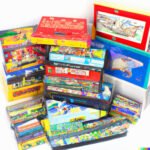Introduction
Board games from the 1950s and 60s have had a lasting impact on modern day gaming. Those years saw the emergence of some of the most classic and well-known board games in existence. The first commercial board game was created during this time, called “The Game of Life”, which has become iconic and remained popular to this day. Monopoly was released in 1935 and remains an enthusiast favorite even today; it’s multi-million dollar professional events are proof enough of its staying power. Other famous titles like Scrabble, Risk, Sorry!, Battleship, Trivial Pursuit also made their debut during this time.
These early board games from the 50s and 60s had a major influence in how today’s video games look and feel. As computer technology advanced more board game franchises were adapted for online play with major success such as Hasbro’s multiplayer online game series. The principles and rules that governed these tabletop classics continue to dominate core game design principles used in AAA titles to this day, most notable is their focus on player interaction, strategy building mechanics while still balancing challenging gameplay scenarios.
Overall, these classic creations have left an indelible mark on modern day gaming culture as they have played an important role in introducing children -and adults- to new fun worlds filled with adventure, learning opportunities along with hours of long standing fun!
Popular Board Games of the 1950s
Monopoly: The world-famous real estate-themed board game, Monopoly was created by Charles Darrow in 1935. The objective of the game is to become the wealthiest player through buying, renting and trading properties. Players travel around the gameboard to purchase properties and build houses and hotels with their earned money.
Scrabble: Scrabble made its debut in 1948. This iconic word game involves players using tiles to create words on the game board that correspond with how much each letter is worth for scoring points. It tests a person’s lexical skill and strategic skills with verbal play amongst players competing against each other during gameplay.
Checkers: Checkers dates all the way back to 3000 BCE. Also known as Draughts, Checkers has been around for centuries, making it one of the oldest known board games worldwide. All you need to play is a checkered board and two sets of pieces – black pieces and white pieces. Two players take turns moving one piece at a time until you reach a position where either your King can’t move or the opponent’s king can’t move – leading to victory!
Chess: This classic strategy game dates back 1500 years ago. Chess involves two opponents playing against each other while trying to capture each other’s King based off strategic moves powered by their 16 playing pieces which include 8 Pawns, 2 Bishops, 2 Horsemen (or Knights), 2 Rooks, 1 King and 1 Queen per side of the board.
Parcheesi: Parcheesi is an ancient Indian crossing race game for two players or teams first released in 1874 by Milton Bradley Company as “The Royal Game of India” before being adopted by Parker Brothers as “Pacheesi”.. The object of the game is navigating four pawns from start to finish while strategically avoiding being captured by opponents’ pawns placed around the board.
Fun Facts about Board Games from the 1950s and 60s
The 1950s and 60s ushered in a new era of board game innovation and creativity. During this time, many classic board games were first created, becoming household favorites. One of the most famous board games of all time, Monopoly, was originally invented in 1933 by an unemployed worker named Charles Darrow ” however it wasn’t until the 50s that Parker Brothers bought his idea and began mass-producing it for national distribution. Scrabble, on the other hand, was patented in 1948 by James Brunot, who concentrated mainly on selling to department stores and Friends and family.
In 1959 two Air Force Officers created the popular game Twister which quickly became a hit – especially after being featured on Johnny Carson’s “Tonight Show.” Chess also saw a surge in popularity during this period with Fischer-Spassky Match making it a worldwide phenomenon. Similarly, Clue’s simple yet captivating concept helped reach audiences around the globe while originally its equipment pieces were made from wood or ceramic so as to make it look more elegant. Strategy games like Risk helped players foster their decision-making skills while absorbing them into a multidimensional world full of adventure.
For many families these board games provided fun for everyone at the dinner table and eventually video game consoles would have to come up with different formats of entertainment so as not to be left behind by these hit classics. On each following decade different innovators thought up new games and rules variants to keep things fresh ” marking an everlasting legacy left behind by board games from 1950s & 60s era.
Benefits of Playing Board Games from the 1950s and 60s
Board Games from the 1950s and 60s provided more than just entertainment, they had educational and social benefits which shaped the lives of many people growing up in this era. As technology progressed board games started to become a technological leap as 3D puzzles and games became popular, allowing players to interact with physical objects in a newly interactive way.
The educational value of these games is hard to miss, with strategy games such as Scrabble or Chess helping young minds learn about organization and tactics, while new nouns and verbs could be learnt through playing experimental game like Copycat or Busytown Mysteries. Back then these simple interactive experiences were considered revolutionary!
In terms of social benefits, Boardgames from the 50’s & 60’s served an important function in bringing families together around the dinner table. They had become popular enough to be used by most family units on a weekly basis, meaning that all ages could get involved. Playing board games was often seen as an expression of decency ” enjoyable but wholesome ” with conversation flouring that would have otherwise been lost when pursuing other activities alone.
Overall, Board Games from the 1950s and 60s served a broader purpose than what might first meet the eye; it kept children entertained for hours at a time but also developed their thinking process whilst bonding families together over dinner – setting standards for what we expect from modern board games today.
Unique Board Games from the 1950s and 60s
The 1950s and 60s saw the development and proliferation of board games that were creative, often timeless, and sometimes quite strange. During this period, some of the most popular games including Monopoly, Risk, and Clue became household favorites. However, there are several lesser-known titles that have been left in the dust over time. These memorable games included Operation (the game where players need to remove little pieces using a forceps without making contact with the shock zone), Mousetrap (where players build a mousetrap machine as they travel around a track), Crazy Clock (a memory game where you race against the clock to find matches) and Twixt (a tactical strategy game where players take turns claiming spaces on a board). Many of these one-of-a-kind board games provide nostalgic pleasure while giving modern players a chance to test their gaming skills.
The Influence of Board Games at Home and in Schools
Board games from the 1950s and 1960s had a huge influence on the lives of many children. Not only were they entertaining, but they were also educational tools that emphasized problem-solving, critical thinking and strategy, skills which could be transferred into all aspects of life. Family time was spent playing board games together as parents taught their kids valuable lessons rather than relying on digital screens to keep them occupied. Board games allowed families to interact with one another and experience positive socialization in a way that computer games would never be able to provide.
Apart from home use, board games found an even more important role in schools. For instance, Scrabble helped increase children’s vocabulary by familiarizing them with words which would otherwise remain foreign concepts. Chess allowed teachers to help develop their student’s cognitive abilities as well as expose them to higher levels of mathematics. In addition, Snakes and Ladders educated students about cultural values such as justice while Chinese Checkers taught important strategies for decision making and negotiation skills.
Moreover, Classroom Bingo created friendly competition among students while teaching number facts; this could easily be adapted for different skill levels like subtraction or multiplication problems instead of numbers being called out. With its easy understanding rules, Children’s Monopoly offered complete immersion into game play exploring marketing concepts such as stocks and businesses capital investments scenarios allowing them to simulate practical trading situations without any real world consequences if the wrong decisions were made.
Overall, board games had a unique place in history during the ’50s and’60s due to their popularity both within the home setting and in schools due to their ability to bring people together regardless of age or class whilst providing essential educational value at the same time. These types of classic competitions have served as valuable lessons for generations when it comes life skills such as cooperation, communication or decision-making processes – teaching basic economic theories which can still be applicable today despite today’s digital era advancements available for young minds worldwide.
Conclusion
Board games from the 1950s and 60s have long been some of the most iconic, nostalgic forms of entertainment. From classic board games like Monopoly, Scrabble, and Clue to lesser-known titles like Super Bowl Football, Hoopla, and Going To The Movies Game, these beloved toys remain widely enjoyed even after all these years. Despite being incredibly simple compared to today’s popular video games, many of these original titles still remain beloved favorites for children and adults alike for generations. The colorful designs, easy rulesets and sociable gameplay have ensured that these classic titles have endured in our collective cultural consciousness for decades ” and still continue to be played in living rooms across the globe today.

I love playing all kinds of games – from classics like Monopoly to modern favourites like Ticket to Ride.
I created this blog as a way to share my love of board games with others, and provide information on the latest releases and news in the industry.





